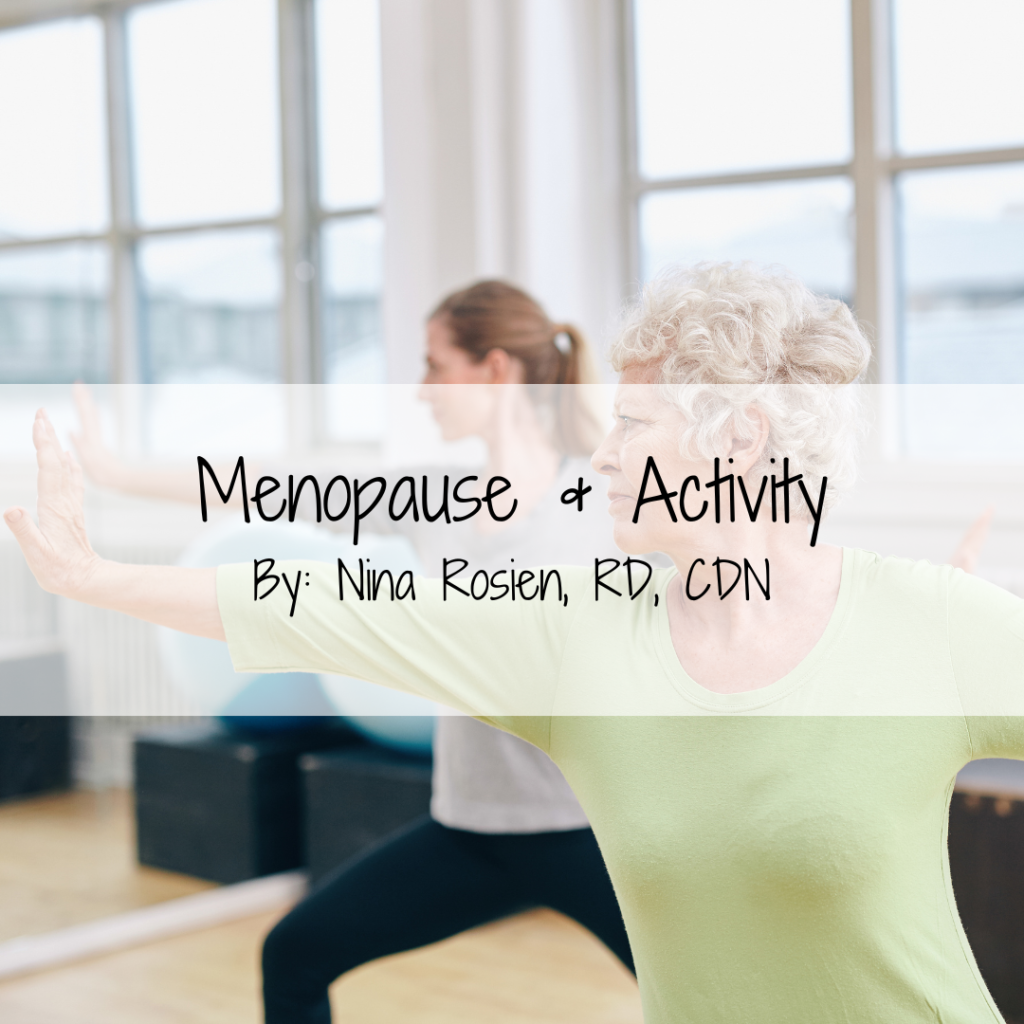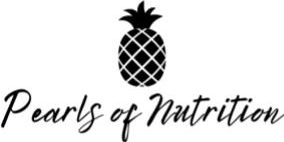
As a certified personal trainer, one of the most common questions I get is: what type of exercise is right for me? This is a question that is so individual for each person. Especially as health changes through the life cycle – our body changes naturally, so should our food? Should our fitness? The answer may surprise you! Menopause is one of those big physical changes that occurs for women. Let’s first take a look at what menopause is, and then understand how fitness must be adjusted during this life change.
Menopause is the end of a woman’s menstrual cycles. It’s commonly known for the presence of symptoms such as hot flashes, trouble sleeping, moodiness and irritability or a combination of these symptoms. But, it can also have significant health-related effects such as increased risk for musculoskeletal issues, cardiovascular disease, depression, and a decrease in bone mineral density and muscle mass.
The menopausal transition can take many years, starting at different ages. It can also vary in length and symptomology for each person. There are also several stages of menopause, and it can be categorized into 4 phases:
- Premenopause – Premenopause is the time before menopause symptoms start. During this stage, women experience normal menstruation cycles but without menopause symptoms.
- Perimenopause – Perimenopause is noted by increased hormone fluctuation, menstrual cycle irregularities, and menopause symptoms.
- Menopause – Menopause is diagnosed retrospectively after the woman has gone 12 months without her period.
- Postmenopause – Postmenopause is when the ovaries stop functioning and menstruation has ceased for at least 12 consecutive months. Menopause symptoms experienced during perimenopause can persist for several years into postmenopause. Still, they will subside once hormone levels have leveled out and the body has adjusted to the difference in hormonal profile.
It’s also important to acknowledge the hormone changes that happen, as this can impact physical and mental risk factors that are important when choosing a fitness or physical activity regimen. One major part of menopause is the diminishing of reproductive hormones, such as estrogen, progesterone, and follicle-stimulating hormones. The change in these hormone levels have a direct impact on women’s health, wellbeing, and affects hormones such as cortisol.
- First, estrogen plays a significant role in bone, skeletal, and heart health and many aspects of mental health, such as anxiety and depression. It also increases “feel-good” hormones and neurotransmitters such as dopamine, oxytocin, serotonin, and norepinephrine. During perimenopause, estrogen levels begin to decrease a few years before the final period and eventually stabilize approximately two years after the last menstrual period.
- Progesterone on the other hand, has a main role of preparing the body for pregnancy by thickening the uterus lining after ovulation. If fertilization does not happen – progesterone will decline, causing the uterine lining to loosen resulting in menstruation. Also, the body can convert progesterone into allopregnanolone, which has calming qualities and helps ease anxiety and stress. In relation to menopause, ovulation stops, which causes a decline in progesterone. This decline could increase risk of mood disorders.
- Follicle stimulating hormone (FSH) is produced by the pituitary gland in the brain, and is responsible for getting an egg ready for conception each month. As estrogen decreases, FSH increases to stimulate the follicle cycle and compensate for lack of estrogen. It is the most commonly used hormone to help determine a menopause state.
- Cortisol is a hormone released by the hypothalamic-pituitary-adrenal (HPA) axis in response to challenging or stressful situations. Unlike other hormones that decline with age, cortisol levels are NOT impacted by age. Its purpose is to regulate the body’s stress response, regulate blood pressure and blood sugar, and control the utilization of fats, proteins, and carbohydrates. Cortisol is naturally higher in the morning and decreases throughout the day. However, cortisol levels can remain high regardless of time when the body remains under constant stress. Estrogen balances out the effect of cortisol. During menopause, when estrogen levels drop, the body is less equipped to cope with stress, creating possible chronic cortisol elevations. Elevated cortisol levels may impact weight, particularly the accumulation of visceral fat which is the type that accumulates around our organs, rather than where it belongs- under our skin.
With this understanding of hormones, we can then look at how other bodily systems respond to menopause. One of the many changes is cardiovascular, as estrogen is protective of cardiovascular health. The decline in estrogen has been linked to changes in vascular function and inflammation. This increases the risk of cardiovascular diseases during the menopausal transition. This is why the risk factor for cardiovascular disease is significantly higher in women than men, which makes the incorporation of appropriate exercise even more impactful to the health of women.
On the neuromuscular side, hormonal fluctuations experienced during menopause can cause disruptions in this system affecting the proper functioning of muscles, tendons, and ligaments. This can worsen age related musculoskeletal conditions such as sarcopenia and osteoporosis. Sarcopenia is age-related loss of muscle mass, strength, and muscle function. Studies have shown that although menopause is accompanied by decreased muscle mass, staying physically active can slow down the decrease in skeletal muscle and even increase lean muscle mass.
Estrogen is also linked to bone health. During the transition of menopause, losing estrogen is associated with steep decreases in bone mass resulting in conditions such osteopenia and osteoporosis.
Lastly, those going through the menopausal transition can have an impact on mental health increasing the risk for anxiety and depression. But don’t worry, physical activity can help!
Exercise considerations during menopause:
Now, after all that fun hormone talk, you’re probably wondering – what exercise can I do to work towards being preventive of all this? Though the exercise recommendations for those in menopause are the same for the general population, there have actually been studies that show there are specific exercise regimens that are more helpful for managing menopause symptoms and increasing quality of life!
One study showed that women who exercise report fewer incidents of depression and mood disorders, and we’re actually seeing more evidence that yoga specifically can decrease psychological symptoms and even risk factors for cardiovascular disease.
Resistance training is another component of prevention. In adult women, resistance training is associated with a reduced risk of multiple chronic diseases. Also, incorporating resistance training may be most beneficial because it increases strength and improves body composition and metabolism. This increase in strength can be extremely beneficial for bone health, in combination with weight bearing exercise and can also help to prevent falls. American College of Sports Medicine, American Heart Association, and the U.S. Department of Health and Human Services recommends that adults perform resistance training for each of the major muscle groups 2 to 3 days per week. These are the muscles of the legs, hips, chest, back, abdomen, shoulders, and arms. Examples of muscle-strengthening activities include lifting weights, working with resistance bands, doing calisthenics that use body weight for resistance (such as push-ups, pullups, and planks), climbing stairs, shoveling snow, and carrying heavy loads (such as groceries and heavy gardening). Per the Physical Activity Guidelines for Americans, no specific amount of time is recommended for muscle strengthening, but muscle-strengthening exercises should be performed to the point at which it would be difficult to do another repetition. When resistance training is used to enhance muscle strength, one set of 8 to 12 repetitions of each exercise is effective, although 2 or 3 sets may be more effective. Development of muscle strength and endurance is progressive over time. That means that gradual increases in the amount of weight, number of sets or repetitions, or the number of days a week of exercise will result in stronger muscles. Check in with your personal trainer for a catered and specific routine and support for injury prevention.
Another type of training to consider is aerobic training (also known as cardio or endurance), especially with a woman’s increased risk factor of cardiovascular disease. According to the Physical Activity Guidelines for Americcans, “Aerobic physical activity preferably should be spread throughout the week. Research studies consistently show that activity performed on at least 3 days a week produces health benefits. Spreading physical activity across at least 3 days a week may help to reduce the risk of injury and prevent excessive fatigue.”
In summary, there are several benefits to incorporating exercise, especially when preventing risk factors for menopause. Exercise recommendations for adults do not change based on menopause, however, your physical abilities may feel different than they did in your younger years. If you are someone who isn’t currently very active, it’s important to start by considering where you are at, and how you can safely continue to build strength and endurance.
*PLEASE NOTE: It is best to work with professionals to determine what is appropriate for you as everyone’s needs are individual. Physical activity needs will be different based on: baseline health, medical and mental health conditions, age, sex, current physical activity level, etc. Checking with your doctor is a great place to start to ensure safety. Next, check in with your Registered Dietitian to ensure you are fueling yourself appropriately for your activity. Finally, work with a certified personal trainer on proper technique and progression of exercises.
Especially for those struggling with eating disorders or compulsive exercise- the following information may not be applicable to you. Please check with your team to ensure any changes to your activity level are done in the best interest of your recovery.
For those looking to put an increase in activity into practice, it can feel overwhelming! Kid’s practice schedules, work, being with or caring for loved ones – there are so many things that can impact our ability to be active. The goal here is to consider where you are at, and where you would like to be. You don’t need to go from a sedentary life to a 7 day/week exercise regimen. For those starting with little activity, any increase in your activity will confer health benefits to your body.
To create more lasting activity changes, consider adding your physical activity into a routine that’s already established in your schedule. For example, take a quick 10 minute walk after lunch or during your kiddo’s lacrosse practice, take a quick hike around the park! For strength training, maybe add a quick core workout before your morning shower or bust out a few push ups and squats when you need a break from your desk.
Below is an example weekly workout schedule. Your current activity level may look nothing like this, and that’s okay. The examples below are basic recommendations meant for educational purposes only.
| Sunday | Monday | Tuesday | Wednesday | Thursday | Friday | Saturday |
| Walk my dog for 45 minutes Nice day, so I pulled weeds and mulch my garden for 90 minutes | Walk 10 minutes on lunch Community Vinyasa Yoga Class | Walk 10 minutes on lunch Resistance training video on youtube that includes warm up and cool down – Upper body | Missed lunch walk – too busy! Walk 30 minutes after dinner- it’s sunny outside! | Walk 10 minutes on lunch Resistance training video on youtube that includes warm up and cool down – lower body | Missed lunch walk – too busy! Long day, too tired when I got home! | Cycling class – 45 minutes Or rest day, see how I feel! |
The example workout schedule seen above is an example of starting to incorporate movement and activity into a 7 day cycle in an effort to meet most, but not all, of the recommendations from the Physical Activity Guidelines for Americans.
How have you created lasting habits around physical activity?
Resources:
NASM Women’s Health Fitness Specialization Curriculum.
DHHS Physical Activity Guidelines for Americans, 2nd edition
NIH National Institute on Aging, What is Menopause?


